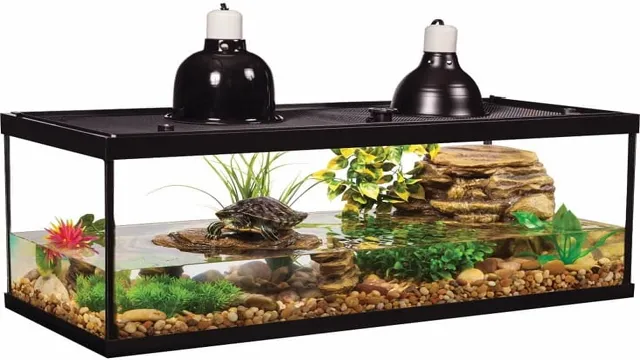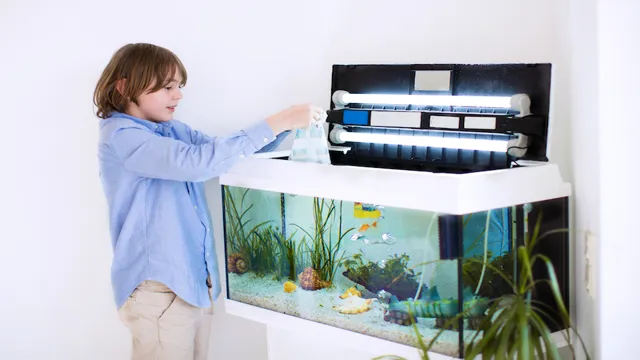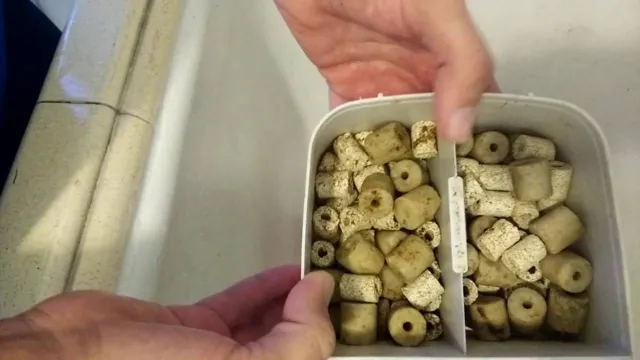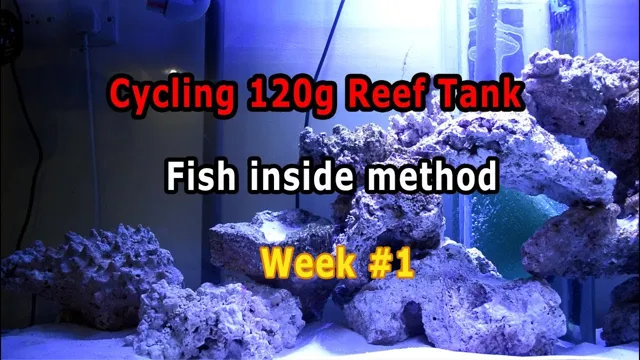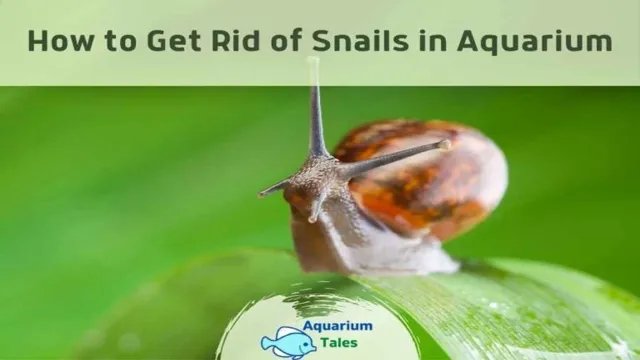Keeping turtles in aquariums is a highly rewarding experience for anyone who wants a unique and fascinating pet. These slow-moving, graceful creatures can provide hours of entertainment as you watch them swim around in their aquatic domain. It’s no wonder why so many people are drawn to the idea of creating a turtle tank in their home.
But before embarking on this journey, there are some important things to consider. In this blog post, we’ll explore the ins and outs of aquatic turtle care and what it takes to create a thriving environment for your shelled friend. So, if you’re ready to learn more about keeping turtles in aquariums, let’s dive in!
Choosing the Right Tank
So you’ve decided to keep a turtle in your aquarium? Congrats! But now comes the important task of choosing the right tank for your shelled friend. Firstly, it’s important to note the size of the turtle you have or plan to get, as they will need enough space to move around comfortably. As a rule of thumb, a tank that’s at least four times the length of the turtle is a good place to start.
Additionally, look for tanks that have a basking area (a raised platform with a heat lamp) where your turtle can climb and dry off after swimming. The type of water filtration system is also important – turtles produce a lot of waste and need a good filtration system to keep their water clean. Lastly, consider the tank’s overall aesthetics.
While it may not be as important as the functionality of the tank, a visually appealing tank can enhance your enjoyment of keeping a turtle as a pet. So go ahead and choose a tank that suits your turtle’s needs and your personal style!
Size and Shape of Aquarium
When it comes to setting up an aquarium, the size and shape of the tank are crucial factors to consider. Choosing the right tank size is important, as it will determine the number and size of fish you can keep. It’s also important to consider the shape of the tank, as this can impact the fish’s behavior and overall health.
A long, rectangular tank is ideal for swimming fish like tetras, rasboras, and guppies since they prefer to move horizontally. On the other hand, tall and narrow tanks are ideal for fish like angelfish and discus that like to swim vertically. While round tanks may look visually appealing, they are not ideal for fish since they don’t have enough surface area to provide ample oxygen exchange.
Ultimately, the size and shape of your aquarium should be based on the type of fish you plan to keep, their size, and their behavior. By taking all of these factors into consideration, you can create a healthy and thriving aquatic ecosystem for your fish.
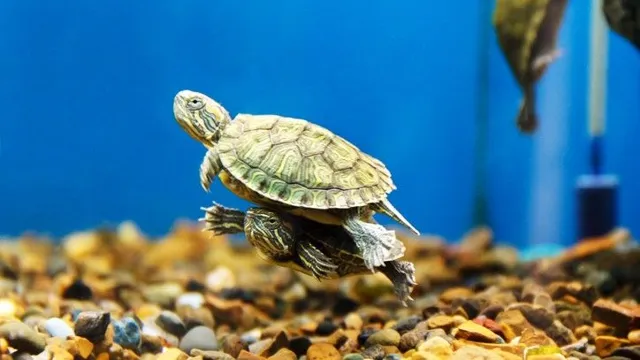
Water and Land Ratio
When it comes to setting up a new aquarium, there are several factors to consider, including the water and land ratio. This is an important aspect to think about, as it determines the types of plants and fish that can be housed in the tank. Generally, it is recommended to have at least 70% water and 30% land, but this can vary depending on your preferences and the species you want to keep.
Choosing the right tank for your needs is crucial in achieving the right balance. A tank that is too small will limit the amount of water and land you can have, while a tank that is too big can make it difficult to maintain proper temperature and water chemistry. Think about the size of the fish and plants you want to keep and choose a tank that accommodates their needs.
With a little research and planning, you can choose the right tank and create a beautiful and healthy aquatic environment for your new pets.
Setting Up the Habitat
If you want to keep a turtle in an aquarium, it’s important to give them a habitat that suits their needs. To start, choose an aquarium that’s at least 40 gallons for an adult turtle. Make sure it has a secure lid to prevent escape and keep out curious pets or children.
Next, create a basking area with a heat lamp, where the turtle can climb out of the water to warm up and dry off. Provide a UVB lamp to mimic natural sunlight, which helps turtles produce vitamin D3 and absorb calcium. Use a filter to keep the water clean and aerated, and provide a variety of aquatic plants and hiding places. (See Also: How to Install Aquarium: A Step-by-Step Guide for Beginners)
Lastly, make sure the water temperature stays between 75-85°F, and feed your turtle a diet of commercial turtle food supplemented with occasional live insects or vegetables. With the right setup, your turtle can thrive in their new aquarium home.
Water Filtration System
Water Filtration System One important factor in setting up a habitat for your aquatic pets is ensuring that the water is clean and free of harmful pollutants. A water filtration system can help maintain a healthy environment for your fish or other aquatic animals. There are different types of filtration systems available, but the most common include mechanical, biological, and chemical filters.
Mechanical filters remove debris and waste particles from the water, while biological filters use beneficial bacteria to break down harmful substances. Chemical filters, on the other hand, use activated carbon to remove impurities and odors from the water. It’s important to choose the right type of filter for your specific needs and to properly maintain it to keep the water in your habitat clean and safe for your pets.
Remember to regularly check and replace filter cartridges or media to ensure optimal performance of your water filtration system.
Heating and Lighting
When setting up the habitat for your new pet, it’s essential to consider their heating and lighting needs. Different species require different temperatures to thrive, so it’s important to do your research and create the ideal environment for your pet. One way to provide heat is through a heat lamp or ceramic heater, which can mimic the warmth of the sun.
It’s also important to monitor the temperature regularly to ensure it stays within the appropriate range. In terms of lighting, some species require UVB lighting, which can help with Vitamin D absorption and overall health. Don’t forget to also provide a cool area for your pet to retreat to if they become too warm.
By understanding and meeting your pet’s heating and lighting needs, you can help them live a happy and healthy life in their new environment.
Substrate and Decorations
When it comes to setting up the perfect habitat for your pet, substrate and decorations play a vital role in creating a suitable environment. The type of substrate you choose will depend on the species of animal. For example, reptiles will require a substrate that can retain moisture without becoming too wet, while small animals like hamsters will prefer a soft, absorbent bedding.
As for decorations, it’s important to provide hiding places and climbing opportunities to keep your pet stimulated and happy. Adding plants, rocks, and branches will help recreate a natural and stimulating environment, while also serving as a source of mental and physical stimulation. Keep in mind that the right substrate and decorations will not only make your pet more comfortable but will also promote their overall well-being.
By creating a safe and engaging habitat, you will provide a space where your furry or scaly friend can thrive.
Feeding and Maintenance
If you are wondering how to keep a turtle in an aquarium, you must first consider its feeding and maintenance needs. Turtles are fascinating creatures, but they require specific care and attention to thrive in an aquarium. To give your turtle the best life possible, feed it a varied diet that consists of both animal and plant-based foods.
Pellets, vegetables, fruits, and live or frozen foods like shrimp or worms are all great options to keep your turtle healthy and happy. In terms of maintenance, make sure to keep the turtle’s water clean and comfortable by changing it weekly and monitoring its temperature and pH levels regularly. Setting up a proper basking area with a heat lamp and UVB light is also crucial to the turtle’s health. (See Also: How to Kill Duckweed in Aquarium: Effective Methods and Tips)
By giving your pet turtle adequate nutrition and ensuring its habitat is comfortable, you can enjoy a rewarding and enriching relationship with your aquatic friend for years to come.
Diet and Feeding Schedule
Feeding and maintaining your pet’s health is a crucial task for any pet owner. Your pet’s diet and feeding schedule play a significant role in ensuring its overall well-being. Choosing the right type of food and feeding it at regular intervals is essential.
Your pet’s dietary needs may vary depending on factors such as its age, breed, weight, and activity level. Therefore, consulting with your veterinarian is crucial in determining the best food and feeding schedule for your pet. High-quality pet food should contain a balanced blend of essential nutrients, such as protein, carbohydrates, fats, vitamins, and minerals.
Feeding your pet too much or too little could lead to health problems such as obesity. Therefore, it’s essential to know the correct amount and frequency of feeding your pet. Remember to provide your pet with enough water to keep it hydrated throughout the day.
A healthy diet, regular exercise, and visits to the vet can keep your pet healthy and happy for many years to come.
Water Changes and Cleaning
One of the most important aspects of fish tank maintenance is performing regular water changes and cleaning the tank. Water changes are essential to maintain a healthy and balanced ecosystem for your fish. The frequency and amount of water you should be changing depends on the size of your tank and the number of fish you have.
As a general rule of thumb, a 20% water change should be performed every two weeks. However, if you have a heavily stocked tank, you may need to perform more frequent water changes. When it comes to cleaning the tank, you should remove any uneaten food or debris on a daily basis.
Also, make sure to clean the tank walls with a soft brush or sponge to remove any algae buildup. Remember to avoid using any chemicals or detergents when cleaning, as they can harm your fish. Regular water changes and cleaning will keep your fish tank healthy and thriving!
Common Problems and Solutions
Keeping turtles in an aquarium can be fun, but it can also present some challenges. One of the most common problems is maintaining clean water. Turtles produce a lot of waste, and this can quickly make the water murky and foul-smelling.
To combat this issue, you should invest in a good filtration system that can handle the amount of waste produced by your turtle. Another problem that can arise is keeping the water temperature at the right level. Turtles have specific temperature requirements, and if the water is too cold or too warm, it can impact their health and well-being.
A good solution is to use a heater to maintain a consistent temperature. Lastly, turtles need a healthy and varied diet to thrive. Many turtle owners make the mistake of feeding their pet the same food every day, which can lead to nutritional deficiencies.
A good solution is to provide a mix of commercial turtle food, fresh vegetables, and live or frozen prey. With a little attention to these key issues, you can keep your turtle happy and healthy in their aquarium for years to come. (See Also: How to Make Bonsai Driftwood for Aquarium: A Step-by-Step Guide)
Conclusion
In conclusion, keeping a turtle in an aquarium requires more than just water and food. Providing a stimulating environment, maintaining proper water quality, and ensuring appropriate lighting and temperature are all essential for a happy and healthy turtle. Just remember, turtles may be slow on land, but they can swim circles around improper care.
So, take the time to research and properly set up your aquarium before bringing home your shelled friend. Your turtle will thank you with many years of waddling and swimming enjoyment!”
FAQs
What size aquarium do I need to keep a turtle?
The minimum recommended size for one turtle is a 40-gallon aquarium. For additional turtles, add an extra 10-20 gallons per turtle.
What kind of heater do I need for my turtle’s aquarium?
A submersible heater is recommended to maintain a water temperature of 70-78 degrees Fahrenheit.
How often do I need to change the water in my turtle’s aquarium?
Partial water changes should be done weekly, replacing about 25% of the water. A full water change should be done every four to six weeks.
Can I keep different species of turtles together in the same aquarium?
It is not recommended to keep different species together as they have different care requirements and may become aggressive towards each other.
What should I feed my turtle and how often?
A variety of foods can be offered including commercial turtle pellets, insects, fish, and leafy greens. Feed juveniles daily and adults every other day.
Do turtles need a basking area in their aquarium?
Yes, turtles need a basking area with a heat lamp to dry off and regulate their body temperature. The basking area should be around 90-95 degrees Fahrenheit.
How do I maintain the cleanliness of my turtle’s aquarium?
Use a filter to keep the water clean and maintain proper water parameters. Remove any uneaten food and feces from the aquarium regularly.

